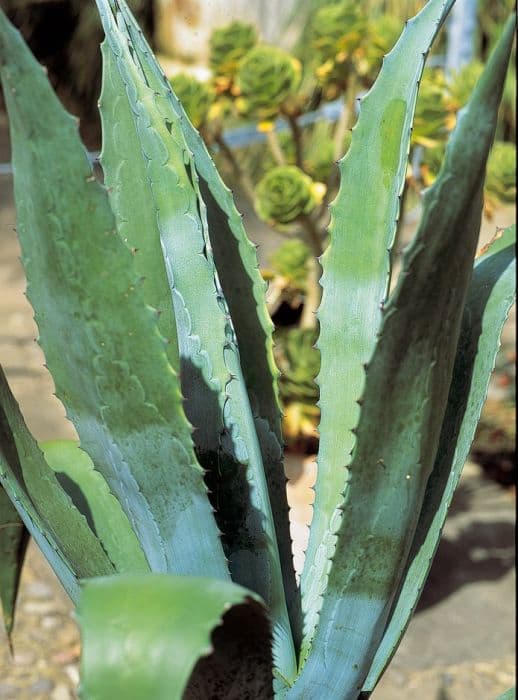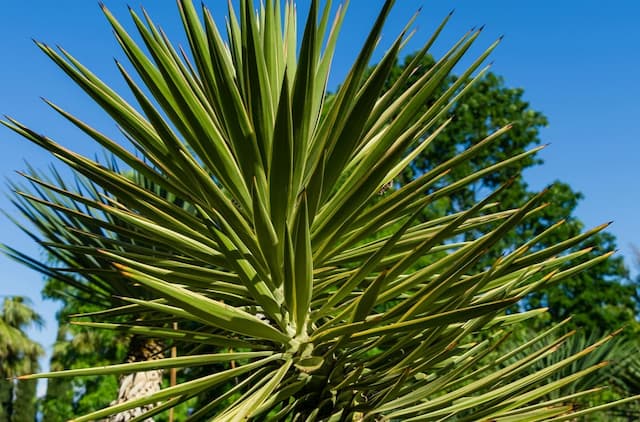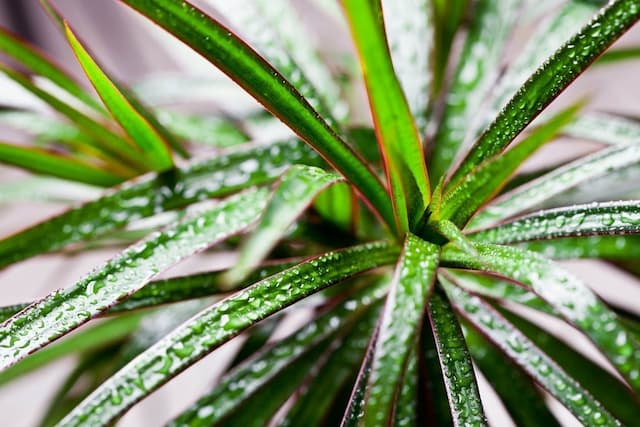Grape Hyacinth Muscari armeniacum 'Peppermint'

ABOUT
The plant in question, commonly known as Grape Hyacinth 'Peppermint', boasts a distinctive and attractive appearance. It produces plump, conical clusters of flowers that resemble bunches of grapes, for which it is named. These blooms are notable for their unique coloration that blends soft shades of blue with subtle white, creating a 'peppermint' effect which adds to the charm of the flowering spikes. The individual flowers are bell-shaped, densely packed along the upright floral stalks, and emit a light, pleasing fragrance which can attract pollinators to the garden. The foliage of the Grape Hyacinth 'Peppermint' consists of slender, lance-shaped leaves that are a rich green in color. These leaves provide a lovely contrast against the colorful blooms and emerge from the base of the plant, typically before the flowers develop. Together, the verdant leaves and whimsically colored flowers make the Grape Hyacinth 'Peppermint' a coveted selection for gardeners looking to add a splash of color to their spring garden tapestry. The plant is often used in borders, rock gardens, or even containers, where it can beautifully complement other spring-blooming flowers.
About this plant
 Names
NamesFamily
Asparagaceae.
Synonyms
Armenian Grape Hyacinth, Garden Grape-hyacinth, Peppermint Grape Hyacinth.
Common names
Muscari armeniacum
 Toxicity
ToxicityTo humans
Grape hyacinth is generally considered non-toxic to humans, and there are no widespread reports of poisoning. However, as with many plants, individual sensitivities can vary, and it is always advisable to avoid ingestion of plant parts that are not commonly recognized as food, as they could potentially cause minor stomach upset or an allergic reaction.
To pets
Grape hyacinth is also not commonly known to be toxic to pets. While it is considered non-toxic, ingestion of the bulbs or other parts of the plant by pets could potentially lead to gastrointestinal discomfort, as is often the case when animals consume non-food plants. If you suspect your pet has ingested a large quantity of any plant material and is showing adverse symptoms, consult a veterinarian.
 Characteristics
CharacteristicsLife cycle
Perennials
Foliage type
Deciduous
Color of leaves
Green
Flower color
Blue
Height
6 inches (15 cm)
Spread
2 inches (5 cm)
Plant type
Bulb
Hardiness zones
4
Native area
Asia Minor
Benefits
 General Benefits
General Benefits- Aesthetic Appeal: Adds a striking blue-purple color to gardens and landscapes.
- Easy to Grow: Requires minimal maintenance and can thrive in a variety of soil types.
- Pollinator Friendly: Attracts bees and other beneficial insects that provide pollination services for gardens.
- Drought Tolerant: Once established, it can survive with limited water, making it suitable for xeriscaping and drought-prone areas.
- Spring Blooming: One of the early bloomers, adding color to the garden when many other plants have not yet started growing.
- Naturalizing: Capable of spreading and naturalizing in an area, producing a fuller, more robust display over time.
- Compact Size: Their small stature makes them ideal for use in borders, rock gardens, or as a ground cover.
- Deer and Rodent Resistant: Less likely to be eaten by deer or rodents, protecting the garden's aesthetics.
- Low Allergenic: Typically does not contribute to allergies, making it suitable for individuals with pollen sensitivities.
- Seasonal Interest: Its distinctive foliage and seed heads can add interest to the garden even after the flowers have faded.
 Medical Properties
Medical PropertiesThis plant is not used for medical purposes.
 Air-purifying Qualities
Air-purifying QualitiesThis plant is not specifically known for air purifying qualities.
 Other Uses
Other Uses- Muscari armeniacum 'Peppermint', commonly known as Grape Hyacinth, can be used as a natural dye, providing a range of blue hues suitable for fabrics and yarns.
- Grape Hyacinth bulbs can be forced indoors in pots for early spring blooms, adding a touch of color to indoor settings during the end of winter months.
- The plant can be integrated into a sensory garden due to its texture and sweet fragrance, offering a multi-sensory experience to visitors.
- These flowers are sometimes used in perfumery to capture their light, sweet fragrance as a base note in floral perfumes.
- Grape Hyacinth clusters can be incorporated into bridal bouquets or wedding decorations for a touch of spring charm.
- Their vibrant blue flowers are ideal for creating natural artworks or botanical arrangements that require small, vividly colored blooms.
- Live plants or cut flowers of Grape Hyacinth can be offered as eco-friendly gifts during springtime celebrations instead of traditional cut flowers.
- These resilient plants can be used in "green roofing," providing a low-maintenance, attractive ground cover for roof gardens.
- When dried, the flowers retain their shape and color well, making them suitable for use in dried flower arrangements and crafts.
Interesting Facts
 Feng Shui
Feng ShuiThe Grape Hyacinth is not used in Feng Shui practice.
 Zodiac Sign Compitability
Zodiac Sign CompitabilityThe Grape Hyacinth is not used in astrology practice.
 Plant Symbolism
Plant Symbolism- Resilience: Grape Hyacinths including the Muscari armeniacum 'Peppermint' often symbolize resilience as they are some of the first flowers to bloom in spring, pushing through the last vestiges of winter.
- Trust: The sturdy and hardy nature of these flowers is often associated with trust, representing reliability and a foundation of dependability in relationships.
- Constancy: Their recurring and consistent blooming pattern each year is linked with constancy, symbolizing steadiness and unchanging affection.
- Beauty: The striking blue of the Grape Hyacinth makes it a symbol of beauty and attractiveness, often used to convey an admiration for natural beauty.
- Positive Energy: The bright and uplifting appearance of Grape Hyacinth flowers is believed to bring positive energy and is often associated with joy and playfulness.
 Water
WaterFor grape hyacinth, ensure the soil is kept consistently moist during the growing season by watering approximately every 7 to 10 days, or whenever the top inch of soil feels dry to the touch. Provide thorough waterings that soak the soil to a depth of a few inches, which is typically achieved with about one gallon of water per square yard of soil, depending on the soil type and environmental conditions. During the plant's dormant period, after the foliage has died back, reduce watering significantly to prevent bulb rot.
 Light
LightGrape hyacinth thrives in full sun to partial shade. The best spot for planting is an area that receives at least 3 to 4 hours of direct sunlight daily. However, some shade during the hottest part of the day can be beneficial, especially in warmer climates.
 Temperature
TemperatureGrape hyacinth can tolerate a wide range of temperatures but performs best within the 60 to 75 degrees Fahrenheit range. While they can survive temperatures as low as 25 degrees Fahrenheit, prolonged exposure to freezing temperatures or excessive heat above 80 degrees Fahrenheit can be detrimental to the plant's health.
 Pruning
PruningPruning grape hyacinth involves deadheading spent flower stalks to conserve the plant's energy. It is best to prune directly after blooming, which is typically in late spring or early summer. There's no need for regular pruning beyond this, as the foliage should be left to die back naturally to nourish the bulbs for the next season.
 Cleaning
CleaningAs needed
 Soil
SoilThe best soil mix for Grape Hyacinth (Muscari armeniacum 'Peppermint') should be well-draining and fertile, with a mix of loam, sand, and compost or well-rotted manure. Ideally, the soil pH should be neutral to slightly alkaline, ranging between 6.0 and 7.5. Adding bone meal to the soil at planting can provide a phosphorus boost for strong root development.
 Repotting
RepottingGrape Hyacinth doesn't typically need frequent repotting as it can grow well in the same pot for several years. However, it may benefit from repotting every 3-4 years to rejuvenate the soil and divide overcrowded bulbs if necessary, ideally after the foliage dies back in the summer.
 Humidity & Misting
Humidity & MistingGrape Hyacinth prefers average humidity levels, typical of outdoor conditions. While it doesn't require high humidity, ensuring good air circulation is important to prevent any fungal diseases, especially in a clustered planting situation.
 Suitable locations
Suitable locationsIndoor
Ensure bright light and cool temps.
Outdoor
Plant in fall, full sun to partial shade.
Hardiness zone
4-8 USDA
 Life cycle
Life cycleGrape Hyacinth 'Peppermint' (Muscari armeniacum 'Peppermint') begins life as a seed that, once sown, will germinate in suitable conditions. The seedling emerges and develops into a bulb, which is the storage organ for the plant, during its first year of growth. Each year, the bulb enters a period of dormancy in late spring after the foliage dies back, a stage crucial for the next growth cycle. In early fall, the bulb awakens from dormancy, and root growth resumes as temperatures decrease and soil moisture increases. Come late winter or early spring, the plant enters its vegetative growth stage, developing long, narrow, green leaves, followed by the flowering stage where the characteristic blue-purple, peppermint-striped flowers appear on spikes. After flowering and seed dispersal, the plant redirects energy back to the bulb to prepare for the subsequent dormancy.
 Propogation
PropogationPropogation time
Spring to early summer
Propogation: The most popular method of propagation for Muscari armeniacum 'Peppermint', commonly known as Grape Hyacinth 'Peppermint', is by dividing its bulbs. Ideally, this should be done after the foliage has died back, often in the late summer or early fall. To propagate, carefully dig up the bulbs and gently separate any offsets—smaller bulbs that have formed attached to the main bulb. These offsets can then be replanted immediately at a depth of around 3 inches (approximately 7.6 centimeters) in well-draining soil, spaced a few inches apart to allow for growth. Watering thoroughly after planting will help to establish the offsets. Replanting these bulbs will result in new plants that will flower in the following spring.









